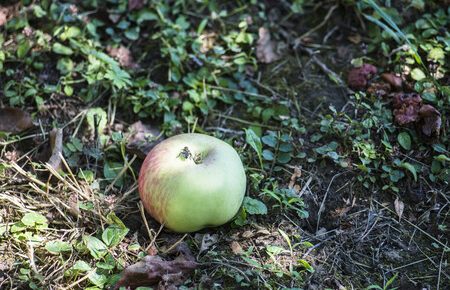
For every tourist in Cambridge, there are some must-see spots like King’s College chapel, the Mathematical Bridge at Queens‘ College, and, certainly, the apple tree at Trinity College. To be precise: a descendent of THE apple tree! Everybody knows the story about Sir Isaac Newton, the falling apple, and the ground-breaking idea about the fundamental laws of gravitation. Now, you might have some doubts whether this specific tree in East Anglia could really be grown from a graft of that exact plant which inspired the famous physicist – as a scientist you should raise doubts already for reasons of profession – but this is not what I want to talk about here.
Newton found something essential: the Earth attracts the apple (so far not very surprising), but the apple also attracts the Earth (admittedly essentially less). The fact that the apple is pulling quite weakly is due to another discovery by Newton: the gravitational force is proportional to the attracting mass. It is worth thinking that through further. If glaciers melt, then the corresponding part of the Earth, say Greenland, loses some of its mass. In comparison to the mass of the entire island and the segment of mantle and core underneath, it is a very small percentage loss. But there is a loss, and it must have, according to Sir Isaac, a consequence on the gravitational field. And, indeed, current technology, such as provided by the satellite missions GRACE and GRACE-FO, is capable of measuring deviations of the gravitational field over Greenland and elsewhere.
This is quite impressive, but it is not the end of the story, because we are heading in the wrong direction. We say: there is a change of mass, so there must be a change of the gravitational field and Newton gives us a formula to calculate the latter change. However, we are actually putting the cart before the horse here. The satellites yield information about the gravitational field at the orbit, and we want to calculate mass anomalies at the Earth’s surface out of that.
A successor on Newton’s Lucasian chair, Sir George Gabriel Stokes, noticed that the arising opposite question – the so-called inverse problem – is by far more difficult to answer and it does not have a unique solution. Science has progressed and today we know for example that mass changes which occur only at the surface (such as melting glaciers) can be uniquely calculated out of the gravitational field. However, if there is (as usual) noise on the data, we will most likely compute a result which is seriously away from reality. Only sophisticated tools – so-called regularization methods – are able to avoid this.
I use the aforementioned problem as an example where incredible measurement technology always needs a very important companion: sophisticated mathematical methods for the evaluation of the data. In geosciences, there is a long tradition of understanding mathematics as a ubiquitous part of research, going back as far as Ancient Greece. The scientific field where Earth sciences and mathematics merge is nowadays called geomathematics.
My book “Geomathematics – Modelling and Solving Mathematical Problems in Geodesy and Geophysics” provides mathematical foundations and tools for different applications in Earth sciences. It particularly focusses on global and regional modelling regarding gravitation, geomagnetics, and seismology. Though different mathematical theories and numerical methods are discussed for the three applications, there are many interconnections between the various problems.
The purpose of the book is, therefore, to provide a reference work for numerous mathematical theories which are fundamental in gravitational and magnetic field modelling, as well as seismology. It also shows some new tools e.g. for best-basis selection. Eventually, my hope is that it encourages more interdisciplinary research between mathematicians and Earth scientists.
Latest Comments
Have your say!